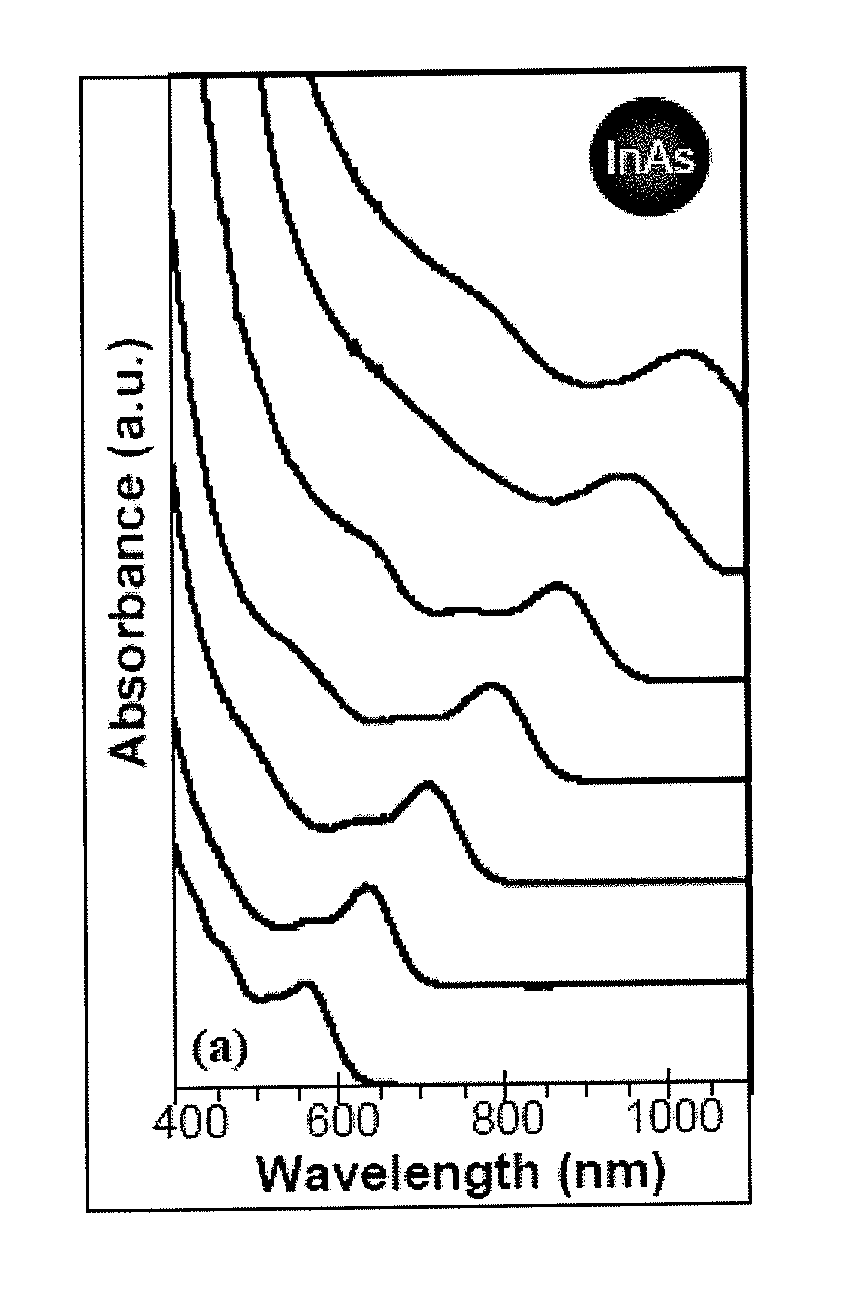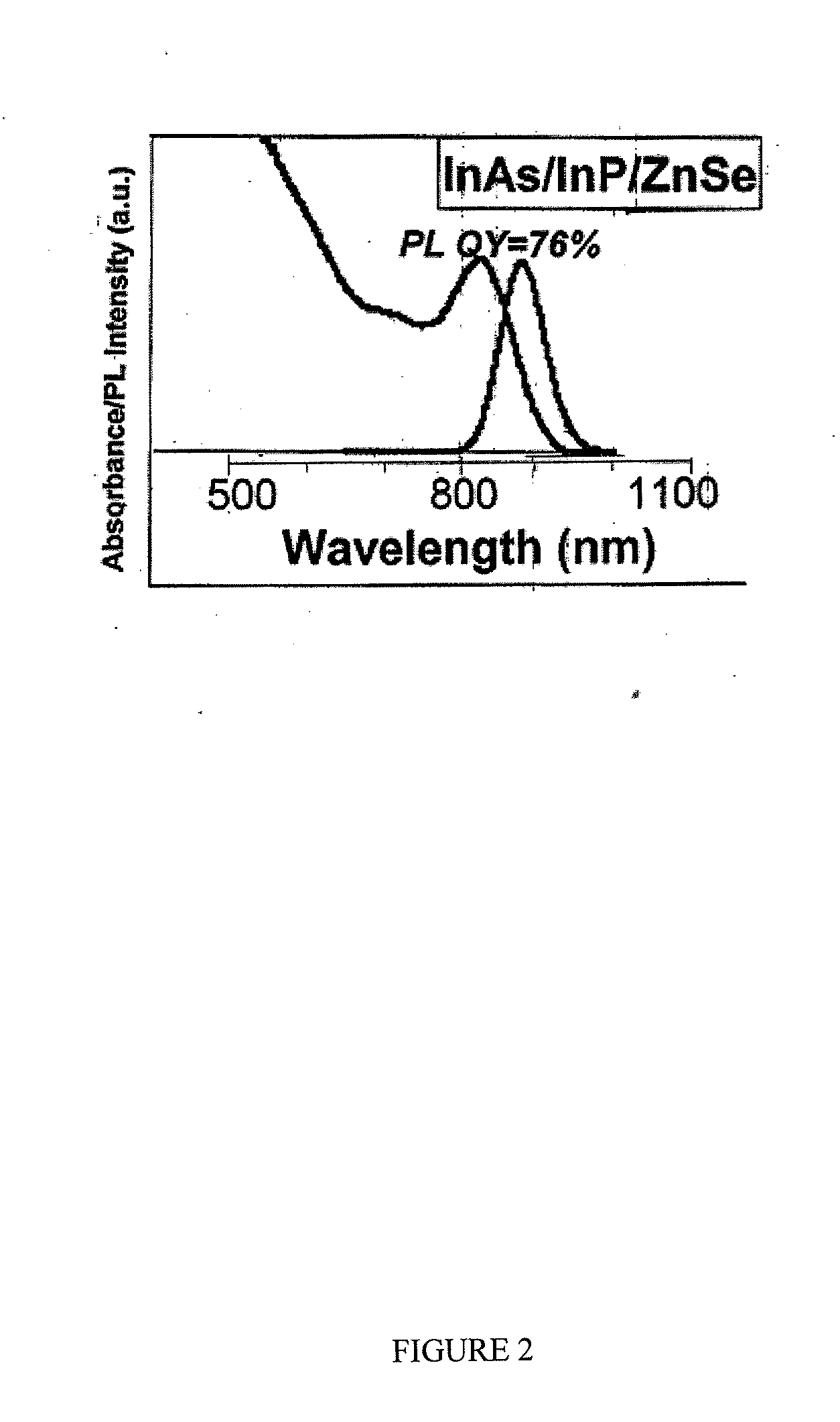Indium arsenide nanocrystals and methods of making the same
a nanocrystal and indium arsenide technology, applied in the field of nanocrystal materials, can solve the problems of out-performing other available biological labels, photoluminescence (pl), current limitations of these materials, etc., and achieve the effect of high photoluminescence (pl) and electroluminescence efficiency and stable against photo-oxidation
- Summary
- Abstract
- Description
- Claims
- Application Information
AI Technical Summary
Benefits of technology
Problems solved by technology
Method used
Image
Examples
example 1
As Prepared Monodisperse or Substantially Monodisperse InAs Nanocrystals
0.4 mM indium stearate, 0.5 ml TOP and 3.5 ml ODE were loaded into three-neck-flask. This mixture was heated to 150° C. under argon flow. An As(TMS)3 solution made in glovebox was subsequently injected into reaction mixture, and then the reaction mixture was heated up to 300° C. for the growth of monodisperse or substantially monodisperse InAs nanocrystals. To monitor the growth of the nanocrystals, aliquots were taken at different reaction times for absorption and emission measurement. FIG. 7 illustrates the as-prepared monodisperse or substantially monodisperse InAs nanocrystals of Example 1.
example 2
As Prepared Monodisperse or Substantially Monodisperse InAs / InP Nanocrystals
InAs core nanocrystals synthesized in Example 1 were cooled to 110° C. 0.3 mM stearic acid (0.5 ml in ODE) was injected into the reaction mixture. A mixture of 1 mM octylamine (0.2 ml) and 0.2 mM (TMS)3P in ODE (0.8 ml) was subsequently added into reaction mixture dropwise. After the addition of P precursor, the mixture was heated to 178° C. and maintained 45 minutes for the growth of InP shell onto the InAs core.
example 3
As Prepared Monodisperse or Substantially Monodisperse InAs / InP / ZnSe Core / Shell / Shell Nanocrystals
InAs core nanocrystals synthesized in Example 1 were cooled to 110° C. and 0.3 mM Stearic acid (0.5 ml in ODE) was injected into the reaction mixture. A mixture of 1 mM octylamine (0.2 ml) and 0.2 mM (TMS)3P in ODE (0.8 ml) was subsequently added to the reaction mixture dropwise. After the addition of P precursor, the mixture was heated to 178° C. and maintained 45 minutes for the growth of InP shell onto the InAs core.
Next, the same procedure was adopted for the growth of the ZnSe shell. When the indium precursor was depleted in the reaction mixture, 0.04 mM Se in TOP (0.2 ml) was injected into reaction vessel with InAs / InP nanocrystals. After 5 minutes, the same amount of zinc precursor was injected into reaction mixture. The temperature was subsequently increased to 220° C. for 30 mM to allow the growth of ZnSe shell. To monitor the growth of the nanocrystals, aliquots were taken at ...
PUM
 Login to View More
Login to View More Abstract
Description
Claims
Application Information
 Login to View More
Login to View More - R&D
- Intellectual Property
- Life Sciences
- Materials
- Tech Scout
- Unparalleled Data Quality
- Higher Quality Content
- 60% Fewer Hallucinations
Browse by: Latest US Patents, China's latest patents, Technical Efficacy Thesaurus, Application Domain, Technology Topic, Popular Technical Reports.
© 2025 PatSnap. All rights reserved.Legal|Privacy policy|Modern Slavery Act Transparency Statement|Sitemap|About US| Contact US: help@patsnap.com



